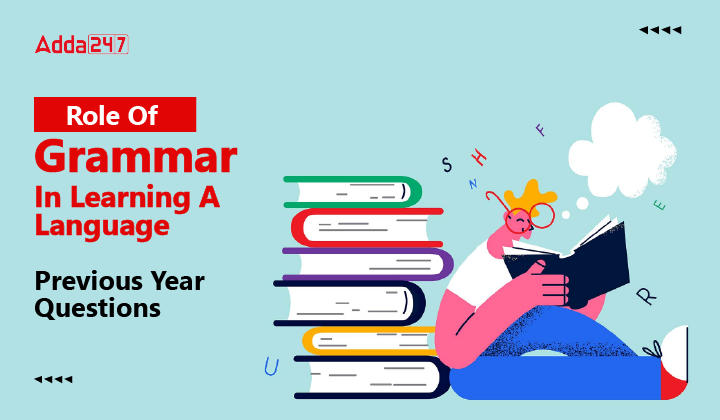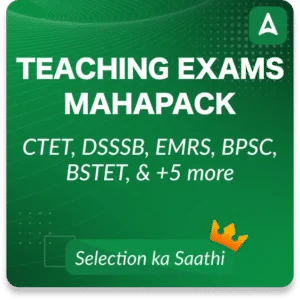English is a compulsory section in various teaching exams, such as CTET and other State TETs, comprising 15 questions on English content and 15 questions on English Pedagogy in CTET and other State TET Exams. Within the English Language sections of teaching exams like CTET and other TET Exams, English Pedagogy holds significance as an intriguing and rewarding topic. This article presents a collection of topic-wise previous year questions to support your preparation.
Role of Grammar In Learning A Language (Previous Year Questions)
Q1. Communicative Language Teaching is concerned with
(a) teaching language to learners for written tests
(b) interpreting grammar rules to suits the audience
(c) enhancing receptive and productive skills such as speaking, listening, reading and writing
(d) teaching of vocabulary and grammar through rules of spelling and language
Q2. When a test item expects the learners to use tense forms, voice, connectors, prepositions and articles accurately, such an approach can be called
(a) mixed grammar task
(b) improper grammar testing
(c) integrated grammar testing
(d) asserted grammar practice
Q3. Minimal pairs are usually used to give practice in
(a) Pronunciation
(b) Reading
(c) Vocabulary
(d) Structures
Q4. I suggest that, we all watch the movie “TIGER”. It has been suggested that we watch the movie ‘TIGER’ together. The two given statements can be differentiated by drawing students attention to the
(a) Change in the verb forms
(b) The roles of the subject and object in both sentences
(c) Use of ‘by’ in the passive form
(d) The arrangement of words
Q5. You have to bring your own stationery. You will need 2 pencils, an eraser and a ruler. The underlined word is a
(a) Substitute word
(b) Reference word
(c) Conjunction
(d) Lexically similar word
Q6. Exemplar for homonym would be
(a) aisle / isle
(b) beer / bear
(c) state / stall
(d) stock / stoke
Q7. Which is a lexical word?
(a) Love
(b) Is
(c) The
(d) Might
Q8. While learning about the passive voice form, students learn about
(a) Use of ‘by’
(b) Position of verbs
(c) Position of nouns
(d) Use of verb form
Q9. Students can leave the school premises at 12: 30 pm.
Student ought to leave the school premises at 12: 30 pm.
The two given statements can be differentiated by drawing student’s attention to the
(a) differences in the arrangement of words
(b) meaning conveyed by the modals / verbs modifiers
(c) the roles of the subject and object in both sentences
(d) absence of change in the verb form
Q10. Identify where the collective form is an error.
(a) Host of angels
(b) Congress of baboons
(c) Clutch of ducks
(d) Shoal of fish
Q11. The politician had been making promises long before election time. The statement is in the ___________________ tense.
(a) Past continuous
(b) Present perfect
(c) Present perfect continuous
(d) Past perfect continuous
Q12. An exemplar of a question to ‘funnel’ or restrict a respondent’s answer is
(a) “What do you think of the weather?”
(b) “How many books are there?”
(c) “Tell me about your most recent holiday”
(d) “What are your goals?”
Q13. In the communicative classroom learners acquire the grammar of second language to
(a) Understand second language better while reading / listening to it
(b) Understand how to make meaning and become more proficient in speaking and writing
(c) Enhance their formal communication skills
(d) Write Confidently
Q14. Structures in second language are better assimilated in a pedagogical practice
(a) Through repetition and practice of commonly used syntax
(b) Through application of learnt structures in discrete language terms
(c) Through meaningful interaction with interesting content
(d) Insisting on accuracy, explicit instruction in rules
Q15. When the teacher quietly observes the students during a collaborative grammar activity, the activity plays a ____________________ role.
(a) diagnostic
(b) evaluative
(c) interactive
(d) record keeping
SOLUTIONS
S1. Ans.(c)
Sol. Communicative Language Teaching (CLT) is an approach to the teaching of second and foreign languages. It emphasizes interaction as both the means and the ultimate goal of learning a language.
S2. Ans.(c)
Sol. When a test item expects the learners to use tense forms, voice, connectors, prepositions and articles accurately, such an approach can be called integrated grammar testing.
S3. Ans.(d)
Sol. Minimal pairs are usually used to give practice in structures.
S4. Ans.(b)
Sol. The roles of the subject and object in both sentences.
S5. Ans.(a)
Sol. The underlined word is substitute word.
S6. Ans.(a)
Sol. Exemplar for homonym would be ‘aisle’ and ‘isle’.
S7. Ans.(a)
Sol. Love is a lexical word.
S8. Ans.(d)
Sol. In passive form, the use of verb form is the most important part of learning.
S9. Ans.(b)
Sol. The two given statements can be differentiated by drawing students’’ attention to the meaning conveyed by the modals/verb modifiers.
S10. Ans.(c)
Sol. Clutch of ducks.
S11. Ans.(d)
Sol. The statement is in the past perfect continuous.
S12. Ans.(b)
Sol. “How many books are there?”
S13. Ans.(b)
Sol. In the communicative classroom, a learner acquires the grammar of second language to understand how to make meaning and become more proficient in speaking and writing. In the communicative competence model, the purpose of learning grammar is to learn the language of which the grammar is a part. Teachers should teach grammar forms and structure in relation to meaning and use.
S14. Ans.(c)
Sol. Structure in second language is better assimilated in a pedagogical practice through meaningful interaction with interesting content which will also modify the grammar.
S15. Ans.(c)
Sol. When the teacher quietly observes the students during a collaborative grammar activity, the activity plays an interactive role.
Download English Study Notes PDF




 HTET Previous Year Questions Papers with...
HTET Previous Year Questions Papers with...
 MPPSC Assistant Professor Question Paper...
MPPSC Assistant Professor Question Paper...
 MPPSC Assistant Professor Previous Year ...
MPPSC Assistant Professor Previous Year ...




